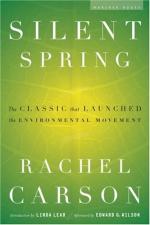
|
| Name: _________________________ | Period: ___________________ |
This test consists of 5 multiple choice questions, 5 short answer questions, and 10 short essay questions.
Multiple Choice Questions
1. Much of the world's water is polluted by ________ from many sources.
(a) Animals
(b) Dirt
(c) Waste
(d) Nuclear plants
2. The title of this chapter comes from Jean Rostand: "The obligation to endure gives us the right to ___________."
(a) Know
(b) Change
(c) Do what we want
(d) Control others
3. What are numerous in both kind and in sheer quantity according to Carson in the opening of the book?
(a) Lakes
(b) Birds
(c) Pebbles
(d) Cats
4. In England, the treatment of _______ with chemicals resulted in widespread bird deaths.
(a) Trees
(b) Soil
(c) Water
(d) Seeds
5. What is the name of the naturally occurring mineral that is toxic to humans and most creatures but is still used as a pesticide?
(a) Carbon
(b) Boron
(c) Lead
(d) Arsenic
Short Answer Questions
1. For almost every human being on the planet, synthetic pesticides are present in _______ and probably in bodily tissues from the beginning.
2. Since the 1940s, more than 200 chemicals have been created for the purpose of _____________.
3. Plants growing in contaminated soil may carry the contaminants into their _____________.
4. Plants and animals specifically ________ to live in whatever their environments are.
5. The town Carson describes _________ actually exist.
Short Essay Questions
1. What do more American children die from today than from any other disease, according to the book as it was written in its own time period?
2. What does man want to replace the American West's sagebrush with?
3. What happened when people in Wyoming unintentionally destroyed the willows in a particular area?
4. What do the mitochondria of cells do within the body?
5. What is the environmental problem that results from all of the water sources of the Earth being connected to each other?
6. What is the basis of all life function, according to Carson's writing in this chapter?
7. What did the chemical warfare of World War II lead to?
8. How are commercial fishermen affected by the spread of chemicals among the fish population?
9. What is the name of the cancer that develops rapidly in patients?
10. Why are chemicals seen as so harmful to the soil and to the life within the soil?
|
This section contains 549 words (approx. 2 pages at 300 words per page) |

|




